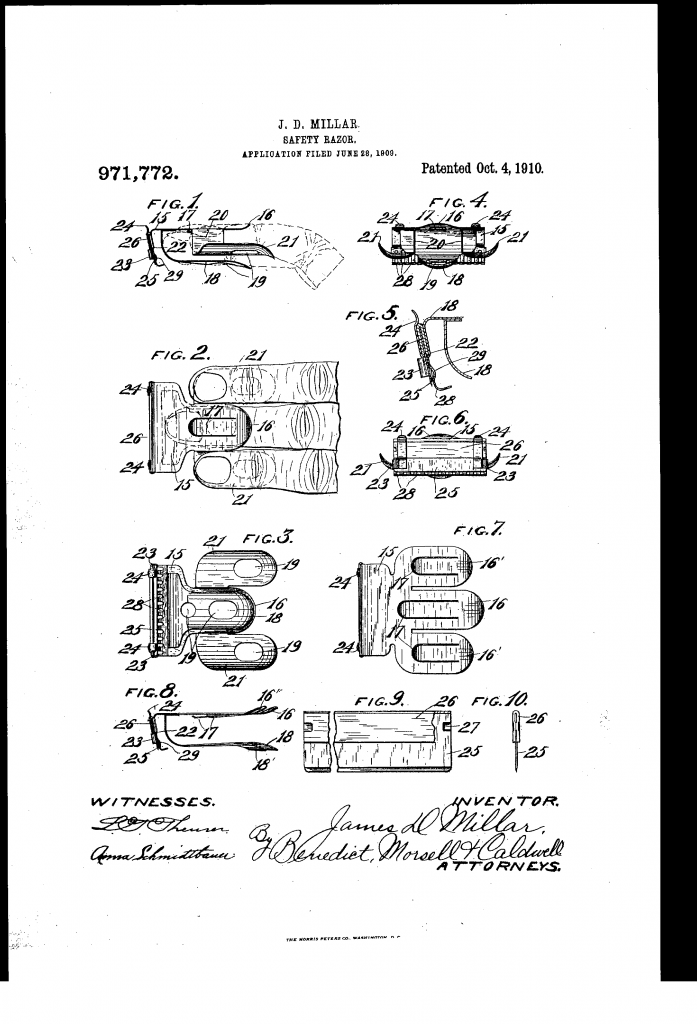Fingerspitzengefühl [ˈfɪŋɐˌʃpɪtsənɡəˌfyːl] is a German term, literally meaning “finger tips feeling” and meaning intuitive flair or instinct, which has been adopted by the English language as a loanword. And what can be more intuitive than running your fingers over your face? At least that seems to have been the logic of James D Millar, who was granted a patent on a fingerspitzengefühl razor in 1910.
Millard’s razor can be described as lacking a handle, like the better known Gronbech razors1 do. But like the later, it does have a handle – just not a normal one.
The razor is interesting in it’s own right too. With a more normal handle, it could have done well. Or perhaps not – competition was fierce in the early days of safety razors.
But let us start by looking at what Millar was trying to achieve, as described in his patent text:
This invention has for its object to provide a safety razor having pocket-like finger clips to fit upon the tips of the fingers of the user and clamp the razor in place thereon so as to avoid the necessity for being clasped by the hand thus permitting the razor to be manipulated by the finger and wrist movements as well as by the arm movements of the user, so as to effect its firm and steady travel in any direction and without jerky movements usual with razors grasped in the hand when moved in an inconvenient direction.
From US patent 971,772
It is certainly a new improvement on safety razors. I’m not sure how useful an improvement it was, given that the patent, razor, and inventor seems to have all but disappeared2 from the annals of history.
Mr Millar’s great idea was to provide the razor with three little pockets for the shavers fingers.3 The shaver could be said to be wearing, rather than holding, the fingerspitzengefühl razor while shaving. According to the patent claims, shaving would be as easy as running your fingertips over your face. I have to say though… going against the grain on the cheeks would involve some gymnastics.

But there is, as I hinted at, more to the fingerspitzengefühl razor than the fingertip feeling. The head and blade is interesting in its own right. The blade is similar to the old type GEM blade, although narrower from front to back. The blade was held in place under a sheet metal loop4 and a pair of spring clips.5 All in all the head should be easy to modify for a modern GEM blade, if anyone are interested. It would make for an inexpensive razor with easily replaceable blades.
While the patent don’t seem to have resulted in a production razor, it have been cited by several other patent applications since 1910. The most recent is a 2022 patent for a proprioceptive6 shaver intended for shaving, uhm, intimate areas.
If you like, you can read the full patent text at Google Patents. If you enjoy these old patents, I have a long list of posts on patents and other shaving oddities.
Footnotes:
- Manufactured by Bigelow and Perkin Co in Pittsburg, as well as by Gronbech’s own company in Woodhaven.
- The patent isn’t even listed in Waits’ Compendium, and Mr Millar didn’t patent any more shaving gear – although he did file patents for a crushing mill and two molding flasks.
- Leaving the thumb and pinky out of the shaving process.
- Called a guide in the patent text, and marked 23 in the drawings.
- Marked as 24 in the patent drawings
- Proprioception, otherwise known as kinesthesia, is your body’s ability to sense movement, action, and location – sometimes described as the “sixth sense”. And no, I don’t know why Craig H. Lichtblau choose that word in his patent.
